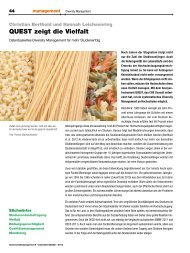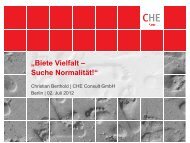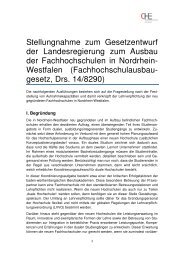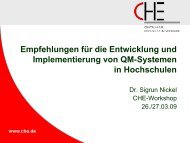Considerations in regards to the survey tool memo - CHE Consult
Considerations in regards to the survey tool memo - CHE Consult
Considerations in regards to the survey tool memo - CHE Consult
Create successful ePaper yourself
Turn your PDF publications into a flip-book with our unique Google optimized e-Paper software.
Moni<strong>to</strong>r<strong>in</strong>g Exchange Mobility Outcomes<br />
- Fac<strong>to</strong>r 6: Curiosity<br />
- Fac<strong>to</strong>r 7: Serenity<br />
- Fac<strong>to</strong>r 8: Decisiveness<br />
- Fac<strong>to</strong>r 9: Disputability<br />
- Fac<strong>to</strong>r 10: Resilience<br />
The fac<strong>to</strong>r analysis will be tested for different cultural<br />
backgrounds dur<strong>in</strong>g <strong>the</strong> test<strong>in</strong>g phase. Also, <strong>the</strong>ir<br />
<strong>in</strong>fluence on <strong>the</strong> <strong>memo</strong> <strong>to</strong>tal <strong>in</strong>dex and <strong>the</strong>ir <strong>in</strong>terconnectivity<br />
with o<strong>the</strong>r study-related aspects will be<br />
analysed for different cultural contexts.<br />
In <strong>the</strong> follow<strong>in</strong>g, we describe <strong>the</strong> mean<strong>in</strong>g of <strong>the</strong><br />
<strong>memo</strong> fac<strong>to</strong>rs as well as <strong>the</strong> mean<strong>in</strong>g of <strong>the</strong> <strong>memo</strong><br />
<strong>to</strong>tal <strong>in</strong>dex. While <strong>the</strong> <strong>memo</strong> fac<strong>to</strong>rs and <strong>the</strong> <strong>memo</strong><br />
<strong>to</strong>tal <strong>in</strong>dex are attributes of <strong>the</strong> students, <strong>the</strong> <strong>memo</strong><br />
data does not aim <strong>to</strong> provide solely an assessment<br />
of <strong>the</strong> students’ abilities <strong>to</strong> <strong>in</strong>teract <strong>in</strong> different <strong>in</strong>ternational<br />
and <strong>in</strong>tercultural contexts but also an<br />
assessment of how well <strong>the</strong> design and management<br />
of study or <strong>in</strong>ternship abroad programmes are suited<br />
<strong>to</strong> enhance <strong>the</strong> students’ <strong>in</strong>ternational competences.<br />
The analysis of <strong>the</strong> added value produced by mobility<br />
programmes <strong>the</strong>refore has <strong>to</strong> be unders<strong>to</strong>od also as<br />
an assessment of <strong>the</strong> roles of <strong>the</strong> home and host <strong>in</strong>stitutions<br />
<strong>in</strong> prepar<strong>in</strong>g <strong>the</strong>ir students for, and guid<strong>in</strong>g<br />
<strong>the</strong>m through, <strong>the</strong>ir experience abroad.<br />
Fac<strong>to</strong>r 1: Confidence<br />
High values on this fac<strong>to</strong>r po<strong>in</strong>t <strong>to</strong> a high degree of<br />
self-sufficiency and a strong conviction of one’s own<br />
abilities – aspects that may positively impact academic<br />
success. Individuals with high values on this fac<strong>to</strong>r<br />
may, however, also be <strong>in</strong>flexible and set <strong>in</strong> <strong>the</strong>ir<br />
ways.<br />
Low values show doubt about one’s own abilities and<br />
perseverance, which might be grounded <strong>in</strong> negative<br />
experiences or <strong>in</strong>security.<br />
Fac<strong>to</strong>r 2: Tolerance of Ambiguity<br />
High values on this fac<strong>to</strong>r mean that a person is capable<br />
<strong>to</strong> <strong>to</strong>lerate <strong>the</strong> behavior and values of o<strong>the</strong>r people<br />
without compromis<strong>in</strong>g his or her own values.<br />
Low values mean that a person feels very uncomfortable<br />
if confronted with o<strong>the</strong>r persons’ different values<br />
and ways of life. Such <strong>in</strong>dividuals may espouse a<br />
more traditional view of th<strong>in</strong>gs, based on <strong>the</strong>ir own<br />
www.<strong>memo</strong>-<strong>to</strong>ol.net<br />
perspective and experience as <strong>in</strong>fluenced by family,<br />
society and established norms and values. Deviation<br />
from what is conceived as “normal” is perceived as<br />
threaten<strong>in</strong>g or at least discomfort<strong>in</strong>g.<br />
Fac<strong>to</strong>r 3: Self-Efficacy<br />
High values <strong>in</strong>dicate that <strong>the</strong> person is conv<strong>in</strong>ced that<br />
he or she can <strong>in</strong>fluence <strong>the</strong> outcome of his or her ambitions<br />
and efforts (such as study results), and that<br />
<strong>the</strong>se are not a matter of luck or co<strong>in</strong>cidence. This<br />
perspective is accompanied by a high self-awareness<br />
and a good assessment of what is expected.<br />
Low values not only suggest that a person does not<br />
feel that he or she really can make a difference with<br />
respect <strong>to</strong> <strong>the</strong> outcome of a certa<strong>in</strong> task or situation,<br />
but he or she also feels a certa<strong>in</strong> ambiguity about <strong>the</strong><br />
demands and conditions of <strong>the</strong> task or situation.<br />
Fac<strong>to</strong>r 4: Sociality<br />
High values refer <strong>to</strong> an <strong>in</strong>dividual, who not only likes<br />
<strong>to</strong> socialise, but who cannot be alone very well. For<br />
<strong>the</strong>se <strong>in</strong>dividuals, an active social life co<strong>in</strong>cides with<br />
good emotional well-be<strong>in</strong>g.<br />
Low values <strong>in</strong>dicate that <strong>the</strong> <strong>in</strong>dividual does not like<br />
<strong>to</strong> m<strong>in</strong>gle, but is better able <strong>to</strong> deal with negative feel<strong>in</strong>gs<br />
such as rejection and is less concerned about<br />
<strong>the</strong> op<strong>in</strong>ion of o<strong>the</strong>rs.<br />
Fac<strong>to</strong>r 5: Vigor<br />
High values reflect a “problem-solver”, who does<br />
not like <strong>to</strong> delve <strong>in</strong><strong>to</strong> <strong>the</strong> <strong>in</strong>solvable aspects of a task<br />
but focuses on <strong>the</strong> doable and also likes a challenge.<br />
Such <strong>in</strong>dividuals may ei<strong>the</strong>r be very pragmatic <strong>in</strong><br />
<strong>the</strong>ir approach <strong>to</strong> academic education, consider<strong>in</strong>g it<br />
as a means <strong>to</strong> solve practical problems, or else very<br />
<strong>the</strong>ory-oriented <strong>in</strong> that <strong>the</strong>y are attracted <strong>to</strong> problemsolv<strong>in</strong>g<br />
as an academic exercise.<br />
Low values reflect an <strong>in</strong>dividual, who is well aware of<br />
problems or problematic aspects of a situation and<br />
might be more concerned with identify<strong>in</strong>g <strong>the</strong> problem<br />
than with solv<strong>in</strong>g it. Accord<strong>in</strong>gly, such an <strong>in</strong>dividual<br />
would be less goal-oriented and may have an al<strong>to</strong>ge<strong>the</strong>r<br />
less future-oriented perspective on th<strong>in</strong>gs.<br />
6














